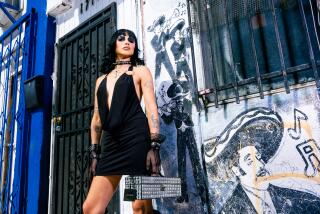Museum showcases female punk scene
Lysa Flores looks far too stylish to be one of the female voices of East L.A. punk, to borrow the subtitle of an exhibition opening next week at the Claremont Museum of Art. Waiting one cloudy morning recently for a table at a trendy cafe in her Los Feliz neighborhood, the singer-songwriter is sporting a red silk scarf under a long gray herringbone overcoat revealing black leggings that stop just above her buckled ankle boots. There are no pinks or blues in her curly black hair and no pins, hoops or studs in her nose or eyebrows.
She brings a burned CD of new music she’s recording and that doesn’t sound punkish either, despite a guest appearance by John Doe of X fame. The autobiographical work, “Immigrant Daughter,” is acoustic, reflective and often poetic, suited for the artist who’s been called the Joni Mitchell of Chicano rock.
So what’s she doing in a museum show focused on a punk scene that exploded in East L.A. in the early ‘80s when she was still a schoolgirl?
“To me, the punk rock idea was always about having this oppositional identity, which is very Chicano to me,” says Flores, a vegetarian who orders fruit and granola. “Even though that was the music I was raised listening to, it would be completely inauthentic to wear the punk rock uniform. You have the ideology and then you have the look. And I think so many people settle on the look without the actual thought behind it. For me, I’d rather turn heads with a song.”
She will try turning some heads with a performance next Saturday at the opening reception for “Vexing: Female Voices From East L.A. Punk,” the exhibition that takes its name from the legendary Eastside punk club, the Vex. She’ll be joined on stage by some of the original Chicana punks who influenced her, including Alice Bag (née Armendariz) of the Bags and Teresa Covarrubias of the Brat. In their act, Flores and Armendariz plan to unveil a brand-new genre called “punkcheras,” or punked-out mariachi standards.
The exhibition documents the often untold story of L.A.’s Chicano punk scene not just through music but via the entire aesthetic of this aggressively subversive genre or, more accurately, way of life. In addition to vintage video of rarely seen performances, the show features paintings, photography and performance art to trace the history of the scene and its legacy. A closing concert will spotlight two younger female bands, Go Betty Go and the Sirens.
In doing research for the show, co-curator Pilar Tomkins discovered a dearth of information on the scene. One punk anthology devoted a single page to the topic, and that included a picture of Los Lobos, hardly a punk band. What’s more, if the men of Chicano punk were ignored, imagine how little is known about the women in what some consider a male-dominated scene.
With the show and catalog, the museum seeks to “illustrate the uniqueness of what these women were doing and how it’s different being a Chicana punk and being any other kind of punk,” Tomkins says. “For them to do what they were doing meant stepping outside of not only gender roles but also socioeconomic conditions, immigrant status and ethnic and cultural roles.”
Armendariz, or Alice Bag, grew up with some of the traditional customs of her Mexican immigrant family. She recalls having to warm tortillas at dinner for her brother, who enjoyed the male privilege of eating first. That subservience may have something to do with the name of her band after the Bags broke up -- Castration Squad.
“Rock ‘n’ roll stands for rebellion, and if you’re feeling disenfranchised it gives you a voice,” says Armendariz, who retired from teaching after 20 years and now lives in San Diego with her husband and their three children. “I wouldn’t be surprised if there’s a group of kids somewhere doing something that’s beyond punk, that’s completely different, channeling their rebellion in a creative way.”
For Chicanos in East L.A., creativity meant channeling their rebellion against the established punk scene of the day, which thrived in Hollywood clubs with bands such as X and the Blasters. Unlike the Bags, which were part of that scene, many Chicano punks felt left out. They were doing a lot of head-banging, but it was against the doors of clubs that would not let them in to play.
Thus, the Vex was born. The club was started in 1980 as an alternative for those shut-out East L.A. bands, including Los Illegals with Willie Herrón, also known for his work with ASCO, the avant-garde Chicano art group. Herrón helped launch the club in a second-story space at the influential Self Help Graphics. What started out as a slap in the face turned out to be “a blessing,” recalls Armendariz, who played the Vex with Castration Squad. “Because from that rejection, from that closed [Hollywood] scene, people just turned around and created their own scene in their own backyard.”
The Vex at Self Help served as an alternative cultural haven, until the place was trashed later that same year by marauding punks from outside the neighborhood during a Black Flag concert. It moved to other locations, but some say it never recaptured the original spirit of shared community.
A decade later, another oasis for Chicano pop culture developed at the Troy Café, operated by Sean Carrillo and Bibbe Hansen, the former Andy Warhol protégé and mother of rock star Beck. It’s where the generations came together, where Armendariz met Flores, who eventually teamed up in the all-girl rock band Stay at Home Bomb, with a drummer who played pots and pans and a bass player who was already eight months pregnant.
In their post-Bags and post-Brat days, Armendariz also teamed with Covarrubias in Goddess 13, a sly numerical reference to Chicano gangs. Later, the pair would join Angela Vogel of Odd Squad, who’s also featured in “Vexing,” to form an acoustic vocal group called Las Tres. The trio played at Troy, sometimes in paper costumes designed by ASCO associate Diane Gamboa, whose work is also showcased at the exhibition, co-curated by Colin Gunckel with support from the UCLA Chicano Studies Research Center.
“Each group of women that comes along kicks the door a little harder,” says Armendariz, about that punk push to be heard. “The [Vex] legacy is that, if you find a door that’s closed to you and you can’t kick it down, then create your own scene somewhere else. You’re not going to be deterred.”
“Vexing: Female Voices From East L.A. Punk.” May 18 through Aug. 31 at the Claremont Museum of Art, 536 W. 1st St., Claremont. $3 for adults; under 18 free. (909) 621.3200; www.claremontmuseum.org.
More to Read
The biggest entertainment stories
Get our big stories about Hollywood, film, television, music, arts, culture and more right in your inbox as soon as they publish.
You may occasionally receive promotional content from the Los Angeles Times.






